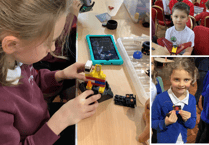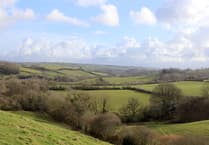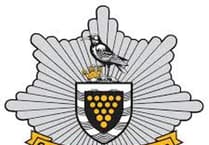Following a successful show last year, the Launceston Agricultural Show committee decided to offer a travel bursary to a group or individual for international travel and to raise the profile of the show association.
They were delighted when Merryn Philp was successful with her application and was able to travel to Canada.
She will have a stand at this year’s show where she will be talking about her time away and how the bursary supported her.
Providing more information about her trip, Merryn told the Post: “I have always been inspired to travel and work abroad in the agricultural sector, and one of the places that has always been on the list since a family holiday in 2011 was Canada. I was always eager to return to the country when in summer 2022 I was inspired to reach out and make contacts in Canada to attempt a trip over there. I knew that I had a month off for my Easter holidays from my course of Agriculture with Animal Science at Harper Adams University and thought that perhaps this was a perfect opportunity.
“I reached out to the Pethick family who were from the local area initially and knew family and friends to myself and my parents. The timing was perfect as calving was planned to begin on April 1, 2023 and my Easter holidays began on March 31. I thought that there was no way I couldn’t go after finding this out. What were the chances.
“Shortly after coming up with a brief plan, I found out that Launceston Agricultural Association offer a travel bursary to young people in agriculture. I thought this was a perfect opportunity and therefore applied for this. It all worked right, and I met with Robert and Claire and was awarded a bursary to cover my travel expenses. I am so thankful for this as my trip came to life and was so much more beneficial due to this sponsorship. Shortly after this I made the big move of booking my flights.
“So, time went on and the date became closer and closer. I Facetimed Ern and Monica just twice before I left whilst messaging them often to discuss plans and details.
“On March 31 I travelled to Heathrow airport and began my biggest adventure yet. After two flights and a drive from Regina Airport north to cross the Manitoba-Saskatchewan border, and into the prairies, I arrived to lots of snow and what would become my new home for the next month. I first met Allistair, shortly followed by the three dogs who weren’t afraid to introduce themselves, and played a very important role of course, Trigger, Marlene, and Lucy. I met Ern and Monica for the first time too and felt welcome immediately.
“Once I was settled in, I went to have a look around and a tour around the farm that I soon got to know Monica and was introduced to my first job of looking after a bucket calf that ended up being my new shadow and best friend! I soon settled into a routine and met the rest of the family, Darren, Markie, Marilla, and Hazel (Marilla also becoming a new best mate of mine with our bucket calf)!
“The daily routine usually consisted of multiple checks of the bred cows in the corral and in pasture, as well as chores which varied day to day as imaginable and then often sorting of calves including tagging and jabbing. On the Monday I visited a nearby purebred Angus and finishing/feed lot farm nearby. I had a tour around the farm and watched embryo transfer of a lot of the herd as well as seeing some of their bulls and most recent purchases which were example of quality stock. I found this an extremely interesting day, as well as when I was invited to visit again to see the flushing before the transfer as I had never seen this myself before. I found it very interesting to see the set up of the farm as well as seeing their bull sale barn on site.
“After this, the routine generally continued with the classic excitement of looking after livestock, no days are ever boring! I quickly became very settled there and one day after doing morning chores, we went on a trip for me to visit a local auction mart to see how they work there, and I found it surprising that the prices the cattle made there can vary so much depending on breed and even markings, such as a skunk tail. One thing I picked up on linked to my job that will begin in June with the Limousin Cattle Society was that Limousin cattle in Canada are farmed much less commonly and make less at market in comparison to in the UK. By the end of the trip, and after meeting an extremely interesting couple and their family who owned a purebred Limousin herd around an hour or two away, I realised that often they aren’t hardy enough for the climate over there explaining why Angus and Herefords are much more popular. However, the family that I visited had bred them for years and enjoy keeping them, having no trouble in selling them. They also spoke to me about showing their stock and how far they travel for shows. They further explained more details about their breeding, and I got to look at the pedigrees and semen tests of the bulls as well as comparing breeding in the UK and common testing here to what they do there.
“I had the chance to visit a Parrish and Heimbecker grain terminal which was enormous, and I found it very interesting to look around and learn about the process and storage of grain of different types and quality, witnessing unloading from semis and super bs as well as loading of train carts. After speaking to staff here, I came away with some very interesting facts. I was told that 6 carts could be loaded per hour assuming all runs smoothly and this grain travels to Great Ontario, with the barley usually all going to feed lots. The scale of the site was nothing quite like I’d seen before.
“Then around a week into my trip, we let the first group of cows and calves out to pasture which was the best sight to see. This week we also took a group of steers to another market, and I got to see the set up of that mart too which was good to see. I also visited the local feed mill and had a tour to see it working as well as the store and the process and system was explained to me. I found this feed side very relevant to my interests in terms of animal feeding and nutrition and it was great to see how the mill worked and how every little detail matters, including heating of feeds and timing.
“I also had tours around more cattle farms. I learn a lot from visiting a variation of set ups and farmers and listening to and discussing their farming techniques and opinions. One amazing set up I visited was a feedlot and farm that owned around 20,000 acres and in total 12,500 head of cattle, to calve 700 cows. The feedlot organisation was amazing to see, in a radial set up with chutes in the middle and treatment areas. This was great to look around and an inspiring system. Another herd I visited was a purebred and pedigree Angus and Simmental herd. They explained to me how their system works and their involvement in showing and sales. I related this to shows in the UK, as I did when I visited the Limousin herd and saw that purebred cattle could be shown and they find it a great opportunity to attract future potential buyers, especially of bulls. Overall, the set ups were reasonably similar, but it was great to see the different sizes and variations to what suits each herd; the use of some farms having feed bunks, calving barns, corral systems and sale barns. I learnt a lot about how they can manage the stock efficiently and cope with the conditions.
“I got the opportunity to go out in the semi on a feed delivery too which was great to experience and see the semis the family use in comparison to the HGVs here. On top of this, I visited a maple syrup ‘farm’. I saw and learnt about tapping the trees and when the syrup is boiled and when most of the sap will drain from the trees for use. This was great to see as it’s something completely different and like nothing I’ve seen before.
“I really cannot thank Launceston Agricultural Association and the Pethick family enough for the experience, it taught me so much and I am so grateful for all the people I got to meet and lessons I learnt. If it wasn’t for the Pethick family, or Launceston Agricultural Association, I would’ve struggled to of had such an amazing experience and it is one I will never forget, as well as people and animals that will stay as memories with me forever. The trip reiterated that working with livestock is the most rewarding job in the world, even at -19 and in snowstorms. It was safe to say I saw it all, as Monica and Ern would say, especially when it came to extreme conditions and coping with wildlife!
“I will create a display to be shown at Launceston Agricultural show on July 27 to explain and demonstrate more about my trip and how the bursary helped me. I am more than happy to talk more about my experience to anyone interested and hope to see many people at the show.”
The show association will be running a travel bursary application process again this year, visit their Facebook page for details.




